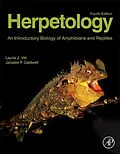The fourth edition of the textbook Herpetology covers the basic biology of amphibians and reptiles, with updates in nearly every conceptual area. Not only does it serve as a solid foundation for modern herpetology courses, but it is also relevant to courses in ecology, behavior, evolution, systematics, and morphology. Examples taken from amphibians and reptiles throughout the world make this book a useful herpetology textbook in several countries. Naturalists, amateur herpetologists, herpetoculturists, zoo professionals, and many others will find this book readable and full of relevant natural history and distributional information. Amphibians and reptiles have assumed a central role in research because of the diversity of ecological, physiological, morphological, behavioral, and evolutionary patterns they exhibit. This fully revised edition brings the latest research to the reader, ranging over topics in evolution, reproduction, behavior and more, allowing students and professionals to keep current with a quickly moving field. - Heavily revised and updated with discussion of squamate (lizard and snake) taxonomy and new content reflected in current literature - Includes increased focus on conservation biology in herpetology while retaining solid content on organismal biology of reptiles and amphibians - Presents new photos included from authors' extensive library
Autorentext
Dr. Vitt is a reptile ecologist who received his Ph.D. from Arizona Sate University in 1976. He was a Professor at UCLA for 8 years and Professor and Curator at the Sam Noble Museum at the University of Oklahoma for 21 years. He currently maintains Emeritus status. He has had extensive field experience in American deserts and New World tropics, especially Brazil. He has published more than 250 research articles and 8 books. Awards include appointment as a George Lynn Cross Research Professor at the University of Oklahoma, membership in the Brazilian Academy of Scientists, Distinguished Alumnus (Western Washington University), Distinguished Herpetologist (Herpetologist League), and two book awards.
Klappentext
The fourth edition of the textbook Herpetology covers the basic biology of amphibians and reptiles, with updates in nearly every conceptual area. Not only does it serve as a solid foundation for modern herpetology courses, but it is also relevant to courses in ecology, behavior, evolution, systematics, and morphology.
Examples taken from amphibians and reptiles throughout the world make this book a useful herpetology textbook in several countries. Naturalists, amateur herpetologists, herpetoculturists, zoo professionals, and many others will find this book readable and full of relevant natural history and distributional information.
Amphibians and reptiles have assumed a central role in research because of the diversity of ecological, physiological, morphological, behavioral, and evolutionary patterns they exhibit. This fully revised edition brings the latest research to the reader, ranging over topics in evolution, reproduction, behavior and more, allowing students and professionals to keep current with a quickly moving field.
- Heavily revised and updated with discussion of squamate (lizard and snake) taxonomy and new content reflected in current literature
- Includes increased focus on conservation biology in herpetology while retaining solid content on organismal biology of reptiles and amphibians
- Presents new photos included from authors' extensive library
Inhalt
Part I Evolutionary History
1. Tetrapod Relationships and Evolutionary Systematics
2. Anatomy of Amphibians and Reptiles
3. Evolution of Ancient and Modern Amphibians and Reptiles
Part II Reproduction and Reproductive Modes
4. Reproduction and Life Histories
5. Reproductive Modes
Part III Physiological Ecology
6. Water Balance and Gas Exchange
7. Thermoregulation, Performance, and Energetics
Part IV Behavioral Ecology
8. Spacing, Movements, and Orientation
9. Communication and Social Behavior
10. Foraging Ecology and Diets
11. Defense and Escape
Part V Ecology, Biogeography, and Conservation Biology
12. Ecology
13. Biogeography and Phylogeography
14. Conservation Biology
Part VI Classification and Diversity of Amphibians
15. Caecilians
16. Salamanders
17. Frogs
Part VII Classification and Diversity of Reptiles
18. Turtles
19. Crocodylians
20. Sphenodontidans
21. Squamates (Snakes and Lizards)
Part VIII Data Sources
Bibliography
Glossary
Taxonomic Index
Subject Index
